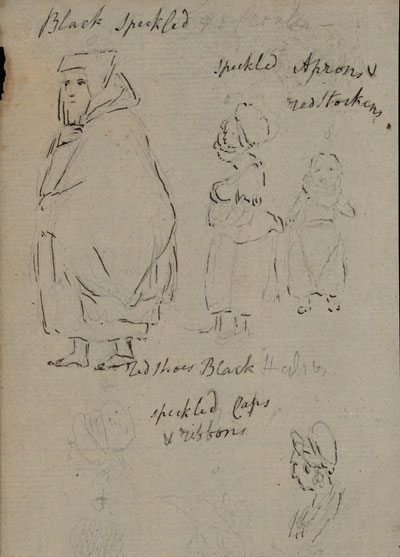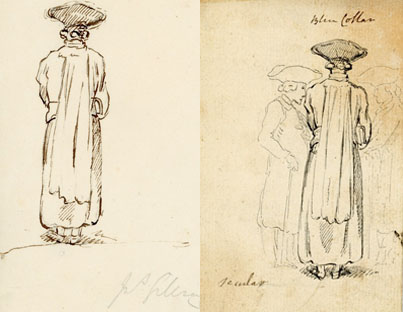[Flemish Characters]
Even people familiar with his work, think of Gillray's Flemish Characters as a pair of prints with that title issued by George Humphrey in 1822, long after Gillray's death. According to the publication line on the two prints, they were "Drawn and Engraved" by Gillray in 1793, but remained unpublished during his lifetime, presumably because of an odd line cutting across the print dividing the upper third from the lower two-thirds.
What most people don't know, or have overlooked (as I did) is that there are at least two extremely rare untitled proofs at the British Museum and the Morgan Library of a single plate version which feature the two scenes from Flemish life appearing one above the other.* In that single plate version, however, the upper third of the 1822 versions is missing.
![[Flemish Characters]](../images/bm_flemish0.jpg)
© Trustees of the British Museum
As in the 1822 version, the first (top) scene portrays the pervasiveness of religion in Flemish life. It shows an orderly line of school girls (tall to short) wearing a standard school uniform as they make their way into the chapel for morning Mass. The fat school mistress has a birch switch hanging from her wrist to maintain discipline. A priest can be seen behind her. On the right, three nuns clothed in black stand aside to let them proceed. A well-to-do family (?) of one of the girls watches from the left. But, most noticeably, the niche where the crucified Christ appears in 1822 is mostly cut off in the single plate version.
Similarly, the bottom scene shows the same bustling market place that appears separately in the 1822 version. At the booth on the far left, a young boy looks on, as a woman takes bets from several men before spinning a wheel which will presumably determine the winner. Next to them is a group of black-robed priests or academics in discussion. One the right another goup of mixed figures gathers around a self-important town crier, while in the background, British troops are drilling for upcoming battles. But in the single-plate version, the upper story of the right hand building is gone as is the tall spire and blue sky.
Both scenes are based on a number of sketches** from the life that Gillray made while travelling with Philip James de Loutherbourg through Holland and France to gather material for a grand painting by de Loutherbourg celebrating the recent British victory at Valenciennes.
At the start of his trip to Valenciennes, Gillray kept a kind of journal or diary some of which is quoted in Draper Hill's biography. (p. 50).*
up about 6—fine Morning—came into port at ostend, about 7 o'clock. . .Went to Morrisons at ostend—House full—breakfasted at— [?Passed] by nuns going to Chapel as we landed—hair dressed by French Hair Dresser—making sketches of Character—went to Market Place—after mass Market open—Games for Prizes—English soldiers relieving Guard (life Guard). . . (p. 50)
It is tempting to think that this early morning walk with its "sketches of Character" the mention of "nuns going to Chapel" the "Market Place," and the "English soldiers relieving Guard" might have been the genesis of the two scenes shown in Flemish Characters. And, as it turns out, there is more than a little evidence for that suspicion. In the same few pages of his journal, there are quick sketches of figures which were clearly reworked at a later time to become part of the two scenes in Flemish Characters.
Here in Gillray's journal, for instance, is the school mistress with the speckled cape before she has been made fatter in subsequent iterations. And at the bottom right is the first sketch of the woman with large earrings who appears with her husband and child in the finished "chapel" design. Above her are sketches of two children who appear in the market scene standing with rapt attention before the town crier.

© Draper and Sarah Hill Collection
The Ohio State University
Billy Ireland Cartoon
Library and Museum
And from two other pages in the same journal we find (with very little change in this instance) the husband of the jewelled woman outside the chapel and the priest with the long billed cap.

© Draper and Sarah Hill Collection
The Ohio State University
Billy Ireland Cartoon
Library and Museum
The sketches make it clear that, for [Flemish Characters] at least, Gillray began with single figures (or a small number of figures) drawn from life and then changed, exaggerated, and combined them to create the resulting humorous but naturalistic scenes. The central cleric or (more likely) academic from the market place scene appears in two different studies now part of The Neil Mundy Collection, first as a single figure, then with two other associates. But, as we know, the demeanor of the figures changed and the number of figures evolved from three to five in the final print.

© The Neil Mundy Collection
After experimenting with a small group of figures, Gillray then seems to have gone on to form them into larger groups and arrange them across the image space. The preparatory sketches for the entire scenes in the New York Public Library, though nearer completion, show Gillray still working out the portrayal and arrangement of figures. In the sketch for the "chapel" scene, for instance, the woman on the far left (holding her child's hand) is still unrealized, and the figure between the man and the school mistress has not yet become the priest with the long-billed cap. The school mistress with the speckled cape is fatter than the one in Gillray's journal, but not as fat as she will become in the final print. The window in the sketch above the line of little girls is removed in the print. The two little girls at the end of the line in the sketch become just one girl, the smallest of the lot. And the nuns in the final print are moved closer to the archway.
The sketch in the New York Public Library for the "market scene" is even more tentative and must have been followed by at least one draft but probably more. The three men and a child in the final print surrounding the woman with a kind of primitive roulette wheel are barely sketched. The monk with the beard chucking a woman under her chin does not appear at all. Nor do the British soldier's drilling in the background. The most finished part of the design consists of the group of five black-robed priests or academics in consultation. In both sketch and print, the tall figure seems to be doing most of the talking, but it is only in the final print that he appears to be reading from a paper in his hand.
The last group, around the (barely sketched) town crier is perhaps least complete in the sketch. The two children are there, but little else. Gillray ultimately removes another figure to make room for a more fully sketched milkmaid now with yolk and pails. He raises the head of another figure (a nun?) so that she apppears at the same level as the milkmaid. And he adds a dog sniffing at the milk.
But in all these sketches and drawings what we don't see is also significant. None of the full preparatory drawings contains any of the details in the upper third of the prints appearing in 1822. To me that is a clear indication that Gillray's original design was the single plate version. And that means that some time after the proofs were taken from that orginal design, someone made the penny-wise but pound-foolish decision to divide the plate into two scenes that would become the two prints we know today as Flemish Characters and to add additional copper to make them conform to a familiar size and format.
I wish I could say that Gillray had no part in this unfortunate decision. But from a close-up view of the 1822 prints, I am convinced that the upper thirds of the prints were, in fact, created by Gillray, and probably (as the 1822 prints suggest) in or around 1793 while he would have had the larger scenes fresh in his mind. My guess is that Gillray thought (or was persuaded to think) he could sufficiently disguise the lines created by joining the upper thirds to the lower two-thirds. And when he found that he couldn't, he forbad the prints from being published. After Gillray's death, however, George Humphrey would have had no such qualms. A Gillray was still a Gillray. And one could hardly blame Humphrey for wanting to share Flemish Characters with the world. In spite of the visible join lines, the two-print versions are still strikingly beautiful and a testment to Gillray's artistic abilities.
* Thanks to Tim Clayton and Omek Marks for correcting my oversight, and alerting me to this wonderful proof and to the existence of additional related sketches at the Billy Ireland Cartoon Library and Museum.
** More sketches from The Neil Mundy Collection, the New York Public Library, and the Billy Ireland Cartoon Library and Museum can be seen in my Gillray Catalogue of Drawings.
Sources and Reading
- Commentary from the British Museum on [Flemish Characters].
- Draper Hill, Mr. Gillray The Caricaturist, 1965, p. 49-50.
- Thomas Wright and R.H. Evans, Historical and Descriptive Account of the Caricatures of James Gillray #397/398
- Thomas Wright and Joseph Grego, The Works of James Gillray, the Caricaturist; With the History of His Life and Times p. 170-1.
Comments & Corrections
NOTE: Comments and/or corrections are always appreciated. To make that easier, I have included a form below that you can use. I promise never to share any of the info provided without your express permission.